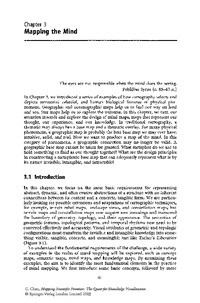Mapping the Mind |
 |
 Diese Seite wurde seit 9 Jahren inhaltlich nicht mehr aktualisiert. Unter Umständen ist sie nicht mehr aktuell.
Diese Seite wurde seit 9 Jahren inhaltlich nicht mehr aktualisiert. Unter Umständen ist sie nicht mehr aktuell. Zusammenfassungen
Zusammenfassungen
 In Chapter 2, we introduced a series of examples of how cartography selects and depicts terrestrial, celestial, and human biological features of physical phenomena. Geographic and oceanographic maps help us to find our way on land and sea. Star maps help us to explore the universe. In this chapter, we turn our attention inwards and explore the design of mind maps, maps that represent our thought, our experience, and our knowledge. In traditional cartography, a thematic map always has a base map and a thematic overlay. For many physical phenomena, a geographic map is probably the best base map we may ever have: intuitive, solid, and real. Now we want to produce a map of the mind. In this category of phenomena, a geographic connection may no longer be valid. A geographic base map cannot be taken for granted. What metaphor do we use to hold something as fluid as our thought together? What are the design principles in constructing a metaphoric base map that can adequately represent what is by its nature invisible, intangible, and intractable?
In Chapter 2, we introduced a series of examples of how cartography selects and depicts terrestrial, celestial, and human biological features of physical phenomena. Geographic and oceanographic maps help us to find our way on land and sea. Star maps help us to explore the universe. In this chapter, we turn our attention inwards and explore the design of mind maps, maps that represent our thought, our experience, and our knowledge. In traditional cartography, a thematic map always has a base map and a thematic overlay. For many physical phenomena, a geographic map is probably the best base map we may ever have: intuitive, solid, and real. Now we want to produce a map of the mind. In this category of phenomena, a geographic connection may no longer be valid. A geographic base map cannot be taken for granted. What metaphor do we use to hold something as fluid as our thought together? What are the design principles in constructing a metaphoric base map that can adequately represent what is by its nature invisible, intangible, and intractable? Chapter 3 [...] extends the metaphors established in Chapter 2 to conceptual worlds. On the one hand, the uniqueness of mapping conceptual systems is distinguished. On the other hand, the intention was to consolidate design strategies and visual representations that can be carried through into the new realm. Memory palaces, for example, echo the constellation figures described in Chapter 2. This chapter also introduces some of the most commonly used methods to derive visual-spatial models of concepts and people's opinions. Examples in this chapter demonstrate not only the use of classic multivariate analysis methods such as multidimensional scaling (MDS) and principal component analysis (PCA), but also the promising route for further advances in non-linear multidimensional scaling. The sizzling-hot topic of small-world networks is introduced as an area of great potential, especially for several themes developed in this book. Small-world networks also offer a structural perspective in parallel to other existing perspectives such as quantitative studies of social networks.
Chapter 3 [...] extends the metaphors established in Chapter 2 to conceptual worlds. On the one hand, the uniqueness of mapping conceptual systems is distinguished. On the other hand, the intention was to consolidate design strategies and visual representations that can be carried through into the new realm. Memory palaces, for example, echo the constellation figures described in Chapter 2. This chapter also introduces some of the most commonly used methods to derive visual-spatial models of concepts and people's opinions. Examples in this chapter demonstrate not only the use of classic multivariate analysis methods such as multidimensional scaling (MDS) and principal component analysis (PCA), but also the promising route for further advances in non-linear multidimensional scaling. The sizzling-hot topic of small-world networks is introduced as an area of great potential, especially for several themes developed in this book. Small-world networks also offer a structural perspective in parallel to other existing perspectives such as quantitative studies of social networks. Dieses Kapitel erwähnt ...
Dieses Kapitel erwähnt ...
 Personen KB IB clear | Vannevar Bush, Manfred Kochen, Stanley Milgram, M. R. Quillian, Duncan J. Watts | ||||||||||||||||||||||||||||||||||||||||||||||||||||||
 Begriffe KB IB clear | Concept MapConcept Map,  Denken Denken thinking, Gedächtnismemory, thinking, Gedächtnismemory,  Geometrie Geometrie geometry, HyperCardHyperCard, geometry, HyperCardHyperCard,  Hypertext Hypertext hypertext, Hypertext-System, Mappingverfahren, MemexMemex, Metaphermetaphor, hypertext, Hypertext-System, Mappingverfahren, MemexMemex, Metaphermetaphor,  Mind Map Mind Map Mind Map, Mind Map,  Netzwerk Netzwerk network, semantic netsemantic net, small world problemsmall world problem, Traveling Salesman ProblemTraveling Salesman Problem, network, semantic netsemantic net, small world problemsmall world problem, Traveling Salesman ProblemTraveling Salesman Problem,  Visualisierung Visualisierung visualization, visualization,  WWW (World Wide Web) WWW (World Wide Web) World Wide Web World Wide Web | ||||||||||||||||||||||||||||||||||||||||||||||||||||||
 Bücher |
| ||||||||||||||||||||||||||||||||||||||||||||||||||||||
 Texte |
|
 Dieses Kapitel erwähnt vermutlich nicht ...
Dieses Kapitel erwähnt vermutlich nicht ... 
 Nicht erwähnte Begriffe | Concept Mapping Software |
 Tagcloud
Tagcloud
 Zitationsgraph
Zitationsgraph
 1 Erwähnungen
1 Erwähnungen 
- Causal Learning - Psychology, Philosophy, and Computation (Alison Gopnik, Laura Schulz) (2007)

 Anderswo finden
Anderswo finden
 Volltext dieses Dokuments
Volltext dieses Dokuments
 |  Mapping the Mind: Artikel als Volltext bei Springerlink ( Mapping the Mind: Artikel als Volltext bei Springerlink ( : :  , 6458 kByte; , 6458 kByte;  : :  2020-11-28) 2020-11-28) |
 Anderswo suchen
Anderswo suchen 
 Beat und dieses Kapitel
Beat und dieses Kapitel
Beat war Co-Leiter des ICT-Kompetenzzentrums TOP während er Dieses Kapitel ins Biblionetz aufgenommen hat. Die bisher letzte Bearbeitung erfolgte während seiner Zeit am Institut für Medien und Schule. Beat besitzt kein physisches, aber ein digitales Exemplar. Eine digitale Version ist auf dem Internet verfügbar (s.o.). Es gibt bisher nur wenige Objekte im Biblionetz, die dieses Werk zitieren.














 Biblionetz-History
Biblionetz-History